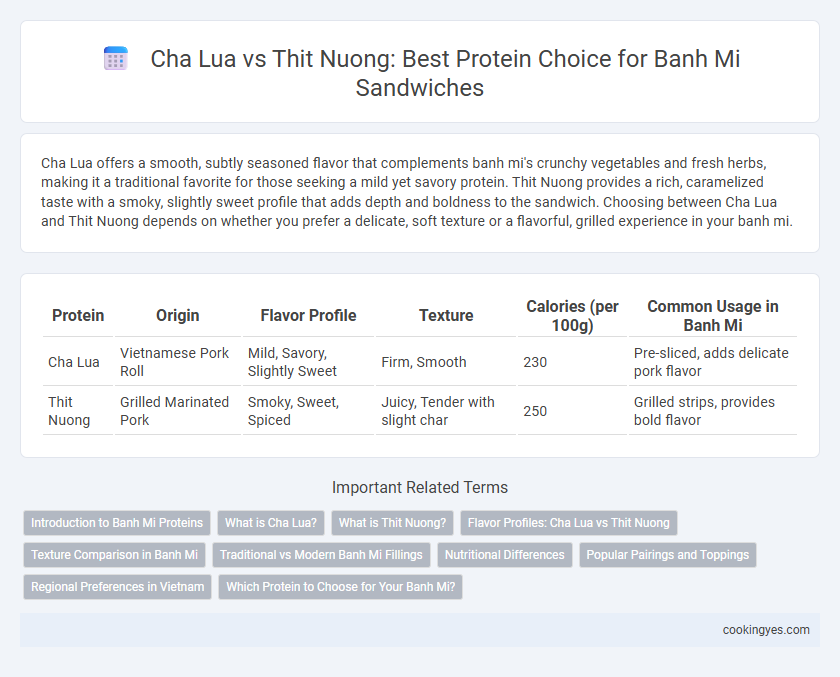Cha Lua offers a smooth, subtly seasoned flavor that complements banh mi's crunchy vegetables and fresh herbs, making it a traditional favorite for those seeking a mild yet savory protein. Thit Nuong provides a rich, caramelized taste with a smoky, slightly sweet profile that adds depth and boldness to the sandwich. Choosing between Cha Lua and Thit Nuong depends on whether you prefer a delicate, soft texture or a flavorful, grilled experience in your banh mi.
Table of Comparison
| Protein | Origin | Flavor Profile | Texture | Calories (per 100g) | Common Usage in Banh Mi |
|---|---|---|---|---|---|
| Cha Lua | Vietnamese Pork Roll | Mild, Savory, Slightly Sweet | Firm, Smooth | 230 | Pre-sliced, adds delicate pork flavor |
| Thit Nuong | Grilled Marinated Pork | Smoky, Sweet, Spiced | Juicy, Tender with slight char | 250 | Grilled strips, provides bold flavor |
Introduction to Banh Mi Proteins
Cha Lua, a traditional Vietnamese pork sausage, offers a smooth, mildly seasoned protein choice for Banh Mi, enhancing the sandwich with its firm texture and subtle flavor. Thit Nuong, grilled lemongrass-marinated pork, provides a savory, smoky contrast that intensifies the Banh Mi experience with its caramelized glaze and robust taste. Choosing between Cha Lua and Thit Nuong impacts the sandwich's flavor profile and texture, catering to preferences for either delicate or bold protein options.
What is Cha Lua?
Cha Lua, also known as Vietnamese pork sausage, is a steamed, finely ground pork loaf seasoned with garlic, fish sauce, and black pepper, offering a smooth texture and subtle savory flavor ideal for Banh Mi. In contrast to Thit Nuong, which is grilled and caramelized with a smoky, sweet profile, Cha Lua provides a milder, softer protein option that balances well with the fresh vegetables and pickled daikon in the sandwich. Its succulent, bland taste enhances the complex layers of Banh Mi without overpowering the other ingredients.
What is Thit Nuong?
Thit Nuong is a traditional Vietnamese grilled pork, marinated with a blend of lemongrass, garlic, fish sauce, sugar, and black pepper, delivering a savory and slightly sweet flavor profile. It provides a juicy, tender texture that contrasts with Cha Lua's smooth, firm pork sausage made from finely ground pork and fish sauce. Thit Nuong enhances Banh Mi by adding smoky, caramelized notes that complement the fresh vegetables and baguette.
Flavor Profiles: Cha Lua vs Thit Nuong
Cha Lua offers a mild, savory flavor with a smooth, slightly chewy texture that complements the freshness of banh mi vegetables and herbs. Thit Nuong provides a smoky, caramelized taste and tender bite, adding a rich, bold depth to the sandwich. Balancing the subtle sweetness of Cha Lua with the intense, grilled notes of Thit Nuong creates distinct flavor experiences in banh mi variations.
Texture Comparison in Banh Mi
Cha Lua offers a smooth, firm texture that contrasts sharply with the crispiness of Thit Nuong in Banh Mi. The dense, slightly rubbery feel of Cha Lua provides a cohesive bite, while Thit Nuong delivers a tender, charred surface that adds crunch and juiciness. This textural difference significantly influences the overall mouthfeel, balancing softness and crispness in the sandwich.
Traditional vs Modern Banh Mi Fillings
Cha Lua, a traditional Vietnamese pork sausage made from finely ground pork and fish sauce, offers a smooth texture and subtle umami flavor that is essential in classic Banh Mi recipes. Thit Nuong, grilled marinated pork with a caramelized exterior, represents a modern twist, providing a robust, smoky taste and chewy bite favored in contemporary Banh Mi variations. The contrast between the delicate, savory Cha Lua and the bold, charred Thit Nuong highlights the evolving protein choices that define traditional versus modern Banh Mi fillings.
Nutritional Differences
Cha Lua, a Vietnamese pork sausage, offers a lean protein option with lower fat content and moderate calories, making it suitable for those watching their fat intake, whereas Thit Nuong, grilled marinated pork, tends to be higher in fat and calories due to its preparation method and marinade ingredients. Thit Nuong provides richer flavors with more saturated fats and sodium, which may impact heart health if consumed frequently. Choosing between Cha Lua and Thit Nuong for Banh Mi protein depends on nutritional goals, with Cha Lua favored for leaner, lower-calorie meals and Thit Nuong for more savory, calorie-dense options.
Popular Pairings and Toppings
Cha Lua and Thit Nuong are two popular protein choices for banh mi, each offering distinct flavors that complement traditional Vietnamese toppings. Cha Lua, a smooth and mildly seasoned pork sausage, pairs well with pickled carrots, daikon, cilantro, and fresh cucumber for a balanced, savory bite. Thit Nuong, featuring grilled pork marinated in lemongrass and garlic, enhances the sandwich with its smoky richness, perfectly matched with spicy jalapenos, mayonnaise, and fresh herbs.
Regional Preferences in Vietnam
Cha Lua and Thit Nuong serve as distinctive protein choices in Banh Mi that reflect regional preferences across Vietnam. Southern Vietnamese Banh Mi often features Thit Nuong, a grilled pork offering smoky and sweet flavors favored in Ho Chi Minh City. In contrast, Northern Vietnam leans towards Cha Lua, a steamed pork roll prized for its smooth texture and subtle, savory taste commonly found in Hanoi-style Banh Mi.
Which Protein to Choose for Your Banh Mi?
Cha Lua offers a smooth, savory flavor with a delicate texture ideal for traditional Banh Mi, while Thit Nuong provides a rich, caramelized taste with a slightly chewy bite that adds depth. Choosing Cha Lua enhances the classic Vietnamese sandwich experience with its mild and balanced profile, whereas Thit Nuong introduces a bold, grilled protein option for those seeking more robust flavors. For a fusion or modern twist, combining both proteins delivers a satisfying contrast of textures and flavors in every bite.
Cha Lua vs Thit Nuong for Banh Mi protein Infographic

 cookingyes.com
cookingyes.com